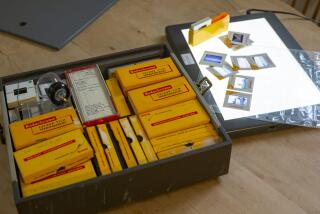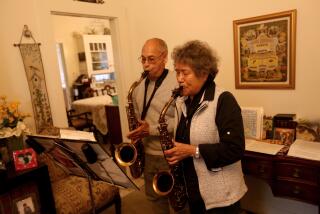Face to face with the past
- Share via
On Monday, I turn 65, an age unimaginable to me when young. And I find the past and the future, my future, lurking all too close, all too fiercely, at hand. Sometimes these days, when I catch a glimpse of myself in the mirror -- the bald head, the mustache that’s gone silvery white, the bumps and discolorations of every sort -- I see my long-dead father staring back. Each time, it’s a visceral shock, this vision of the past, developing like some snapshot, in my own face.
Thought of another way, however, that familiar face embedded in mine offers a considerable span of history. In one merged face, he and I cover a century of change, carnage and promise so unsettling that it too is almost impossible to take in.
The son of a poor immigrant who made good in America, my father was born in 1907. I have, on my wall, a photo of him, at perhaps age 2, his older sister, in a white dress, sitting beside him on a little bench, her arm proudly around him. A big white house and trees are behind them, part of what must be turn-of-the-century Flatbush in Brooklyn, where they grew up.
Perched on that seat, he looks tiny, fragile and like a porcelain doll, but nothing like the man I knew. There’s not a hint of the angry bull of a father who raged through the 1950s, as likely to be unemployed and drinking as anything else. Nor can I see the prosperous salesman/businessman of the 1960s, nor the elderly gent (with a mustache like mine) with whom I spent so much time after his stroke in the late 1970s.
My father rarely spoke of his own life -- his parents, his childhood, the Depression or, above all, his experiences in World War II. Like many Americans, his urge was to leave the past behind, and he was typical as well of a generation that did not come home from the grimmest of wars with the idea that they were “the greatest.”
He was 22 when the stock market crashed in 1929, employed by the Swift Meat Packing Co. He was in his mid-20s when the Nazis rose to power in Germany and our relatives (some of whom he would later help escape from Austria) began, as Jews, to feel the heat.
In December 1941, at the age of 34, soon after the Japanese struck Pearl Harbor, he volunteered for the Army Air Corps and was sent to India as operations officer for the 1st Air Commando Group, a glider outfit striking behind Japanese lines in Burma. I have a single photo of him in full uniform, just before departure, looking handsome, hesitant and uncharacteristically vulnerable.
And it’s here, as America’s wars in Europe and the Pacific reached a crescendo of destruction, in July 1944, that I -- the other half of that merged face -- enter the picture. He was 37 then and had been reassigned to the Pentagon. His son arrived just in time to celebrate the triumph of American science and technology, the dawning of a new age.
In the race to be born, the atomic bomb beat me into existence by four days. It was first tested in the New Mexican desert on July 16, 1944. On July 20, I was born at Lenox Hill Hospital in New York City, less than 13 months before an A-bomb would depart the bomb bay of the Enola Gay and, in an instant, annihilate Hiroshima.
Soon enough, the Cold War began, with two nuclear-armed superpowers going at it by proxy, inscribing their nightmare version of a global war for domination on the bodies of Koreans, Vietnamese, Laotians, Cambodians, Afghans and others.
The Atomic Age was an age of horror but also of promise: From the ashes of war, new wonders would emerge (as well as further ashes). Indeed, the arms race and the race for the good life were now put on the same 24/7 “war” footing. In the 1950s, all the promised big-ticket items -- electric refrigerators, automatic clothes washers and television, which, as one wartime ad promised, would “pull pictures from the air”-- tumbled into new American homes.
The TV set entered my house in April 1953, and I had the red-baiting Sen. Joe McCarthy to thank for it. My mother, a cartoonist, had been asked by the (then-liberal) New York Post to draw the Army-McCarthy hearings, which were shown in the afternoons on ABC.
Soon enough, of course, McCarthy was gone, but TV was forever. The screen had entered our private lives, and it began to multiply. More than half a century later, screens are everywhere -- bars, airports, taxis, gas pumps, hair salons, cars, the doctor’s office and, of course, your pocket, not to speak of the bedroom, bathroom and just about any other place you want to name.
It’s been a dizzying journey, these last hundred years, so much odder, so much fiercer than we could have imagined. We don’t have a picture of it yet. Not really. We’re still waiting for the face -- the actual face -- of the past to appear in a mirror, or on one of those many screens of our lives, to tell us where we’ve really been and where we may be going.
Surprises abound. For 65 years, my face lacked my father, at least when I looked anyway. Now, entering my 66th year, he’s back to take another bow, and that is fierce.
The world reveals itself to us in its own sweet time, just as my father waited all these years after his death on Pearl Harbor Day 1983 to remind me that I’m his child and that I was shaped by his world.
Who knows when you’ll glance into a mirror and meet a past you hadn’t expected and weren’t ready for -- or, for that matter, a future. After all, that can happen too.
If you care to look, you can see the outlines, the shorelines of our world changing even as I write this. For the future, “dizzying” might hardly be the word.
Look in the mirror and tell me what you see.


